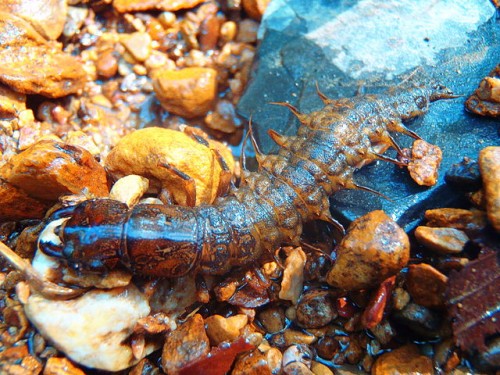| Phylum: | Arthropoda |
| Class: | Insecta |
| Order: | Megaloptera |
| Family: | Corydalidae |
Identification Tips:
• Large; 25-90 mm
• Long, slightly flattened body
• Large head with thick, toothed jaws projecting from head
• Head and thorax (leg area) are hardened, but abdomen is soft
• Thick, flexible, pointed gills protrude from most abdominal segments
• two small, unsegmented appendages with hooks protrude from end of abdomen
Life History:
Larvae are mobile predators; prey includes blackfly, midge, and caddisfly larvae
Many types occupy sheltered areas among cobble, boulder, or large wood debris in fast flowing areas of rivers
• Others are burrowers in sediments ponds, wetlands and large river habitats
• A few species are found in ponds, wetlands or seeps
• Obtains oxygen through filamentous gills protruding from most abdominal segments
• Some species tolerate low oxygen levels and warm water temperatures
| POLLUTION TOLERANCE | ||||
| Very Sensitive | Somewhat Sensitive | Facultative | Somewhat Tolerant | Very Tolerant |
| Most | Some | Some | ||
––––––
Primary Information Source:
Voshell, J. Reese. 2002. A Guide to Common Freshwater Invertebrates of North America. McDonald and Woodward Publishing Company. Blacksburg, Virginia.

